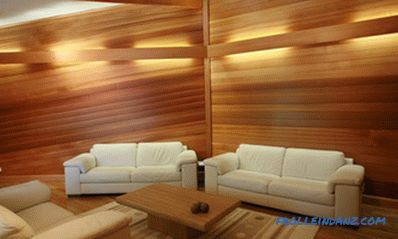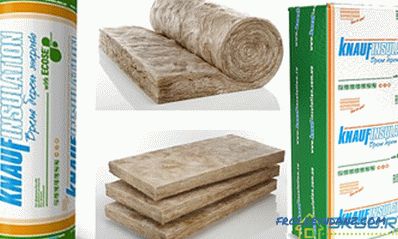Among various short curtains, it is Roman that stands out for its special practicality and external aesthetics. They are in great demand, and manufacturers produce them in various forms: traditional and without a frame, with convenient control mechanics, plain and patterned, from dense and translucent fabrics. A large selection of patterns and colors allows you to choose beautiful short curtains for the bedroom, living room and other rooms. Roman curtains look harmoniously in the interior of different styles: antique, classical, country and modern.

The design of Roman curtains
The design of the very first Roman curtains consisted of a rectangular canvas on which rings were attached. They stretched tapes that regulate the length of the canvases. Modern products differ from the ancestors by a convenient mechanism for lifting the web, otherwise they are equally practical and functional.
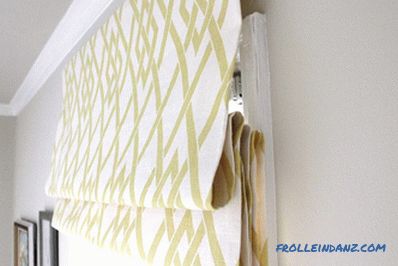
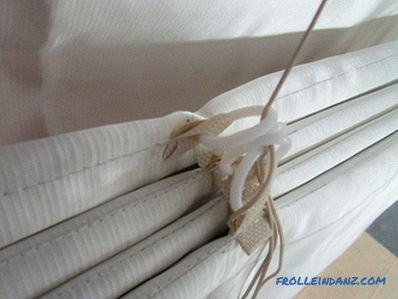
The design of modern products.
The Roman curtains are made up of such details:
Fabric is a rectangular base made of natural, synthetic or blended fabric.
The tulips are horizontal pockets in which the rods are attached.
Rods are the basis of the Roman blinds frame, thanks to which the canvas is folded into identical even folds. The rods are hard and soft, they are inserted into the drawstring, giving the rigidity and shape of the canvas.
The weighting agent is a strip of plastic or metal, which is sewn along the lower tucked edge of the product for even tension of the fabric.
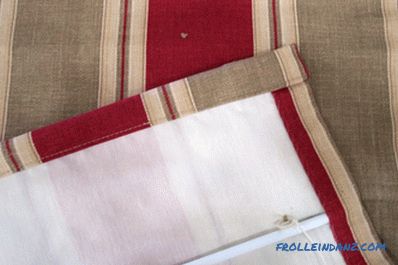
A weighting agent sewn into the fabric from the wrong side.
The lifting mechanism is a system of rings sewn from the inside of the canvas at the level of the backstage bands and ribbons that are threaded into these rings.
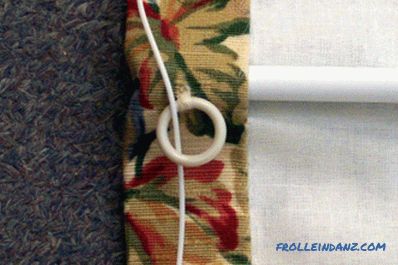
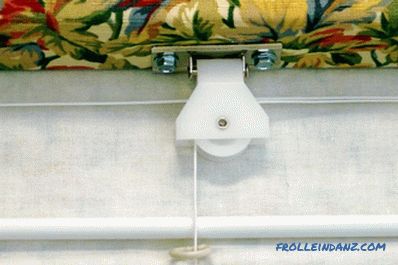
Lifting gear.
Note: the Roman curtain in the interior has a more finished look, if its lower edge is decorated with an additional decor (tassels, fringe, glass bead) or has an elegant wavy edge.
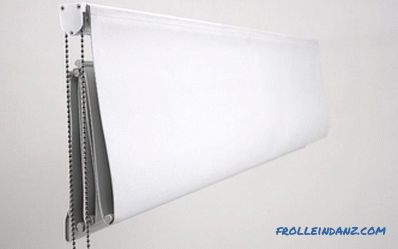
Classic curtains with decorated edges.
What are the types of Roman curtains?
The main basic principle that is common to all types of Roman curtains is the control method. The canvas rises and falls, folding in flat folds, with the help of a chain or lace. At the same time, it can be fixed at any convenient height. All Roman curtains are conventionally divided into several types according to the type of formation of folds.
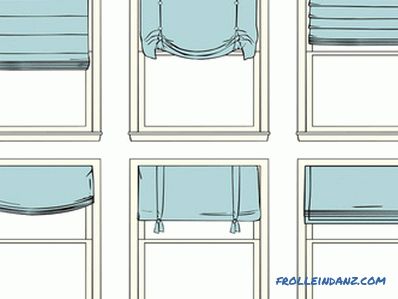
Types of Roman curtains.
Classic
The most common type is, of course, the classic one. It is characterized by the following features:
- when lifting the canvas, smooth beautiful folds are formed, which fit the bottom edge of each other;
- when the window is closed, the canvas is leveled, completely closing the window space, at the same time, it looks absolutely flat;
- in the curtains of classic curtains, flexible rods are attached, which form fabric folds.
Classic Roman curtains in the interior of the living room, nursery or bedroom look elegant, simple and modern. Designers gladly place them in the kitchen or bathroom, as even in the smallest room they occupy a minimum of space.
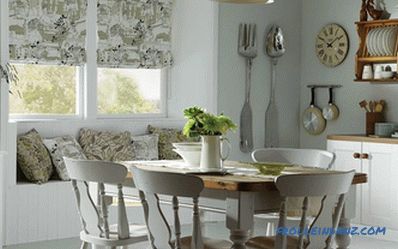
Classic look in the interior of a country kitchen.
Frameless
The main difference between frameless and classical products is the absence of horizontal rods. Thanks to the rods in the classical model, even folds are formed. In the frameless model folds sag, creating a sense of simplicity and harmony. These curtains are great in the recreation area, as they contribute to relaxation and peace.

Frameless curtains in a cozy bay window.
Cascade
Such curtains, even in fully uncool form, have uniform horizontal folds, which are arranged in a cascade. These Roman curtains are more festive and formal than the classical ones, and are more suitable for a living room.
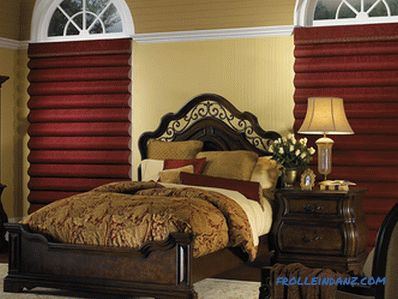
Cascading drapes of the color of wine cherry in the baroque bedroom.
What materials are used to make Roman curtains
Elegant Roman curtains may look different, depending on the color, texture and pattern of the fabric from which they are sewn. For the hall choose curtains of thick Jacquard, satin, muslin with or without a pattern. The fabric does not let in sunlight and well protects from prying eyes, and besides it looks solemn, even in a single-color design.
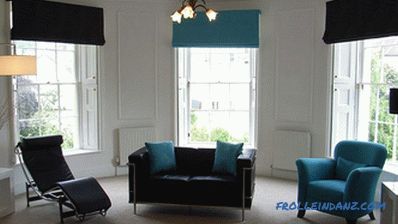
Dense monophonic curtains.
For a library or work area, translucent lightweight fabrics are selected that cover the window from prying eyes and let in light. For example, flax or organza.
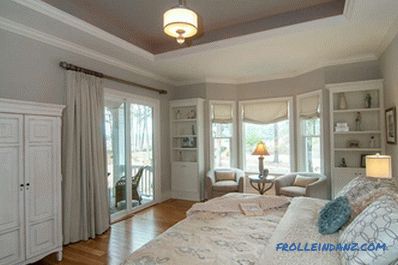
Translucent linen curtains.
It is important for the nursery and the bedroom that the curtains do not let the light in during rest or sleep. Therefore for these rooms it is better to choose dense synthetic fabrics with the minimum transparency.
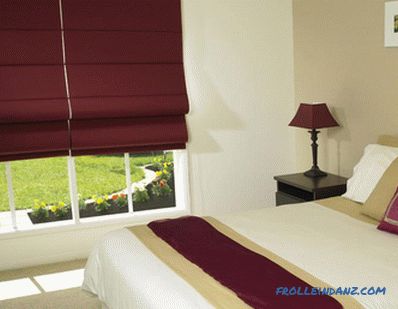
Blackout curtains in the bedroom.
The degree of light transmission of various types of fabric:
| Fabrics that do not transmit light. | Vinyl, satin, blackout, canvas, jacquard, curtain fabric. | Pass from 0 to 10% of the light. |
| Translucent fabrics. | Flax, cotton, crepe satin, acrylic, acetate, muslin. | Pass from 25 to 40% of the light. |
| Transparent fabrics. | Veil, lace, organza. | Pass from 50 to 90% of the light. |
Cotton fabric
Cotton is a natural material that passes light well, but is easily wrinkled. It is rarely used in its pure form, most often with the addition of synthetic fibers that improve the properties of cotton.

+ The advantages of cotton fabric
- naturalness;
- inexpensive cost;
- bright colors;
- softness.

- Disadvantages of cotton
- heavily crumpled;
- shrinks after washing;
- burns out in the sun.
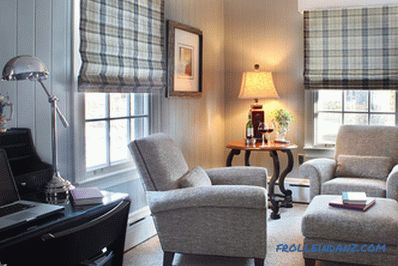
Cotton Roman blinds.
Linen fabric
Linen Roman curtains in the interior are used unpainted, in their natural light gray tint. Linen fabric is a noble natural material smooth to the touch.

+ The advantages of linen fabric
- naturalness;
- high wear resistance;
- does not shrink or shed after washing;
- does not crumple.

- Flawed flaws
- strongly crumpled;
- does not have dimensional stability.
Linen curtains are happy to be used in ethnic, Mediterranean, village interiors in their natural form.
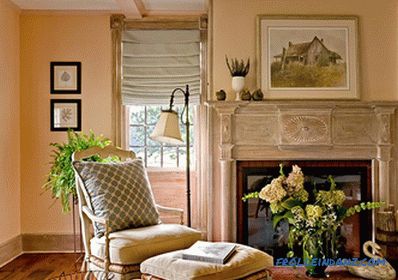
Linen linen in the living room.
Synthetic fabrics
Synthetic fabrics are more often used for sewing curtains.

+ The advantages of synthetic fabrics
- do not crumple;
- differ in different textures and colors;
- have different light transmission from 0% to 90%;
- have dust-repellent properties;
- do not need frequent maintenance.

- Disadvantages of synthetic fabrics
- some tissues are deformed by heat or easily ignite;
- may burn harmful substances when burned.
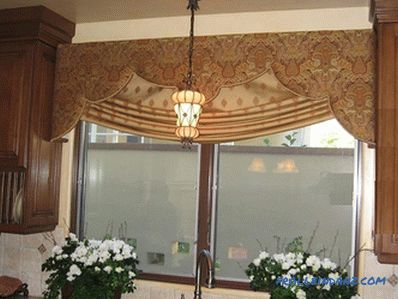
Frameless synthetic curtain with a rigid lambrequin.
Blended fabrics
A canvas woven from a mixture of natural and synthetic fibers is called blended. Such fabrics are very practical, have a large range of names, differ in various degrees of light transmission.

+ Advantages of blended fabrics
- less natural fabrics wrinkle ;
- do not shrink.

- Disadvantages of blended fabrics
- electrified ;
- the formation of the pellets.
Methods of fastening Roman curtains
Roman curtains can be mounted on the eaves (ceiling, side) or directly on the surface.
There are several ways of fastening:
- the canvas is fixed to the eaves above the window opening;
- if there are several small windows on one wall, then the canvas
- are fastened to the frame of each window; if the large window consists of several sashes, then for ease of opening, the curtains are fixed separately on each sash; so that the canvas does not sag.

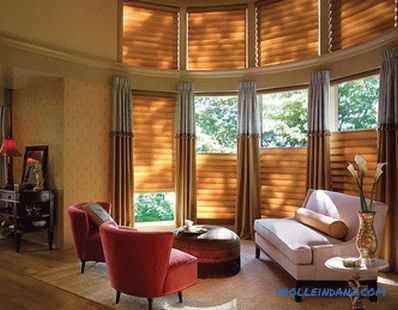
The Roman curtain in the interior is assembled from the bottom up, and vice versa. It is possible to fix a cloth at any height.
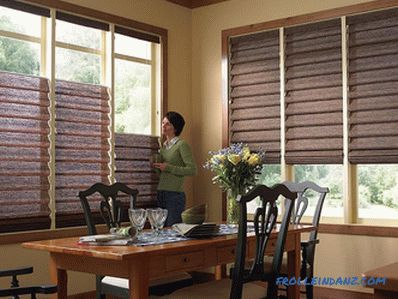
Various ways of fastening curtains (top-down and vice versa.)
Note. The design of the curtains suggests that the canvas will be gathered in folds during lifting. But it does not disappear completely under the eaves, but remains visible at the level of the last fold.

Fastening the Roman curtains onto the eaves.
Proper selection of color and design of curtains
The color of long curtains is carefully selected to match the wallpaper, upholstered furniture or textiles. After all, long curtains are an important decorative element that occupies a significant place in the design of the room. With short curtains is a completely different story, because they take up little space, and when assembled they are almost invisible. If Roman curtains are combined on the window with other types of curtains, then they play a secondary role.
Most often neutral colors are chosen for them:
- white;
- beige;
- light gray;
- sand.
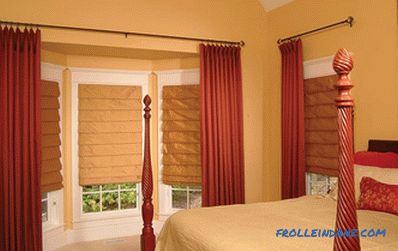
Sandy linen to match the bedspread on the bed in combination with red curtains.
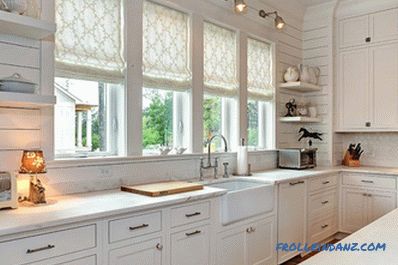
Neutral curtains in the white kitchen.
For minimalistic mono-interiors, the following options are suitable:
- canvas with bright patterns;
- curtains with geometric patterns;
- canvases with bright side piping.
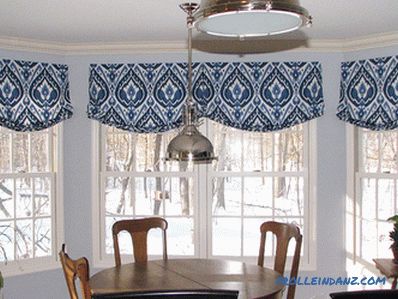

Curtains with a bright pattern is a bright accent on the background of plain walls.
In what cases it is advisable to use Roman curtains in the interior
Practical Roman curtains in the interior of the living room look as organic as in the kitchen or on the balcony. This effect is achieved thanks to their exceptional versatility. But in some cases, a short curtain of the correct geometric shape is even more preferable than a lush pelmet or long curtains:
1. If the storage system is located right under the window, the storage system is designed or a soft corner is located, then long curtains will not be able to hang, as they will interfere with and constantly break off.
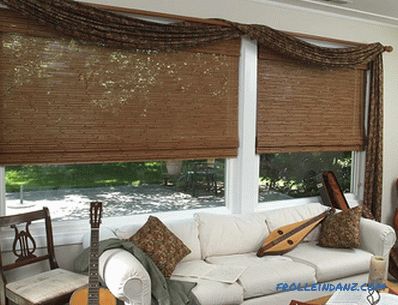
Successful use of short curtains.
2. If the window in the kitchen is located in the work area, and right under it is a sink or table.
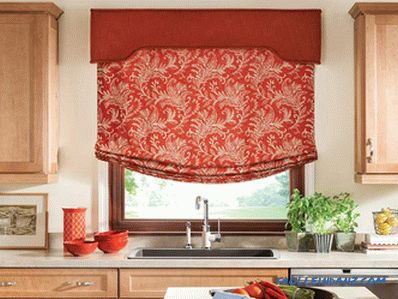
Frameless model in the interior of the kitchen.
3. When entrance doors with glass inserts and a window in a country house need to be decorated in the same style.

Textiles for door and window decoration.
4. When there are a lot of windows in the bedroom, when using a long window curtain on each of them, there may be an effect of textile design overload and design overload.

Bedroom decor with cascading Roman drapes.
5. If we are talking about the design of a children's bedroom, then the use of Roman curtains is justified many times - when closing, they do not let the light through, guaranteeing proper rest, and in the open state completely expose the window and let through the maximum light necessary for study or reading.
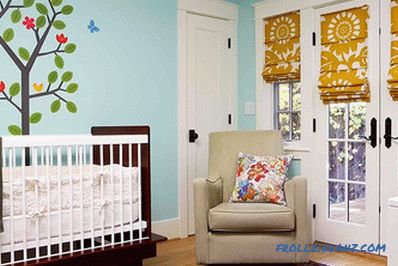
Thick curtains in the nursery.
Which curtains work well with Roman
Designers use several ways to combine short and long curtains when decorating rooms:
1. The Roman blind in the interior serves as protection from light and prying eyes, it is selected from a dense opaque fabric. At the same time, the window is decorated with beautiful curtains, which play the main decorative role.
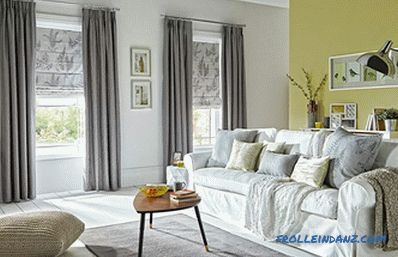
In combination with portieres.
2. Short canvases complement the voluminous lambrequin in a single color range. The decorative function in this case falls on the lambrequin, and the Roman curtain is only the complement of a harmonious ensemble.
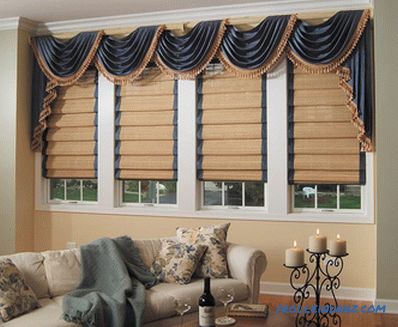
In combination with lambrequin.
3. Short and long curtains are matched in a single tone, and complement each other, creating a single ensemble.
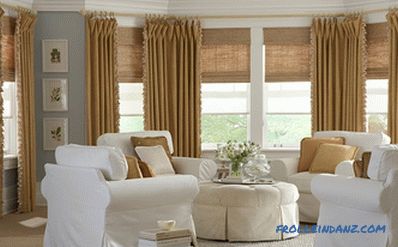
A harmonious combination of Roman and long straight curtains.
Using Roman curtains in various rooms
Bedroom
The traditional use of long, bulky curtains with a pattern or classic lambrequins in the bedroom can be easily replaced in a modern way. - drape windows with cascading or frameless Roman curtains. Roman curtains in the interior of the bedroom look soft and elegant, the main thing is to choose the appropriate option.
To make the curtains organically fit into the room's situation, select thick cascading Roman curtains for windows, which can be hung at different lengths, and use Japanese curtains of the same color instead of doors in the dressing room. The canvases will perfectly harmonize with each other, and they will successfully fulfill their functional load.
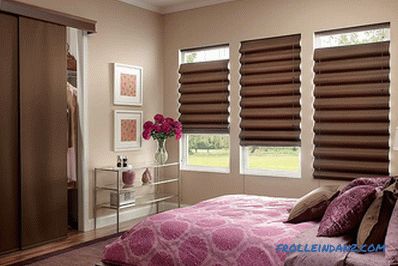
A combination of Japanese and Roman paintings in the bedroom.
Choose a fabric color that follows the basic colors of the room.
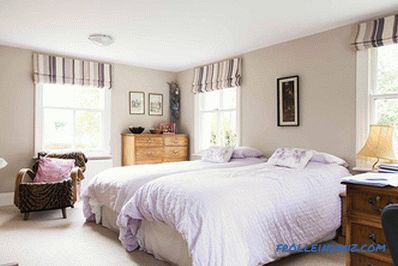
Cotton classic Roman draperies in the bedroom.
Roman curtains in the interior of a nursery are just a godsend. However, the selection of the shape and color of products must take into account the age of the child and his preferences. Too bright colorful curtains can wear a baby, and a teenager will be delighted with laconic dark or bright monophonic draperies.
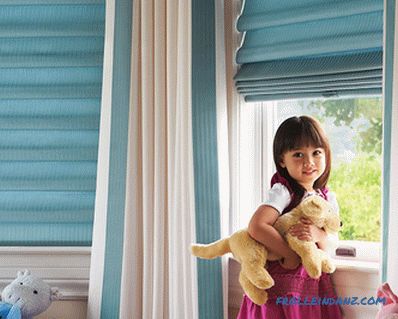
Plain curtains in the nursery.
Kitchen
The conditions of kitchen space in an apartment and house can be different: a large and small area, a comfortable or forced arrangement of furniture, high and low ceilings. But despite this, short curtains will suit any kitchen. Roman curtains in the interior of the kitchen do not take up extra space, do not create discomfort, while they are enough to raise during cooking or washing dishes in order to keep them clean longer.
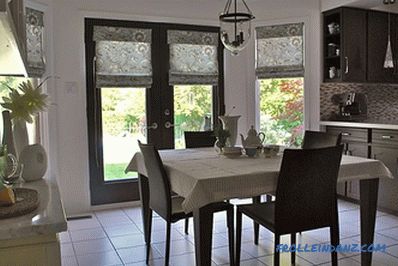
Curtains on the doors and windows in the kitchen.
Living room
Since the living room is a meeting place for guests or a family gathering, the beauty of the design plays an important role in it, and practicality goes by the wayside. Therefore, the textile design of the room is selected with special care.At the same time, the principle of harmonious combination is used, and textiles are selected in the color of the surrounding environment. Or, on the contrary, they use a contrasting principle, making color accent on curtains.
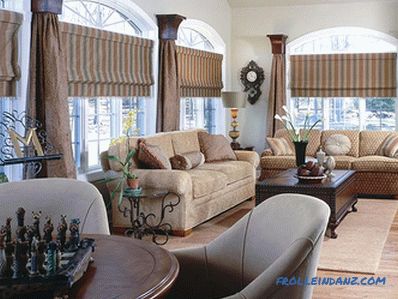
A harmonious combination of textile design and room design.
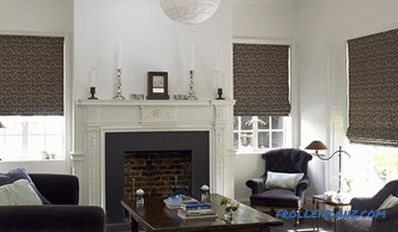
Contrast draperies in the living room.
Roman blinds help to create a non-trivial and at the same time comfortable design. They gently emphasize the dignity of the room, do not reduce the space. Even a child can easily manage them. The variety of types and ways of decorating Roman draperies is quite large. Here are some more inspiration ideas.

